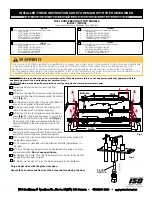
13
NOTE: DIAGRAMS & ILLUSTRATIONS ARE NOT TO SCALE.
Schedule 40
Black Iron Pipe
Inside Diameter (Inches)
Schedule 40 Pipe
Length (feet)
Natural
Gas
Propane
Gas
0-10
1/2
3/8
10-40
1/2
1/2
40-100
1/2
1/2
100-150
3/4
1/2
150-200
3/4
1/2
Table 6
Proper Sizing of Gas Line
Properly size and route the gas supply line
from the supply regulator to the area where the
appliance is to be installed per requirements
outlined in the National Fuel Gas Code, NFPA
54 - latest edition (USA) or CAN/CGA-B149.1
- latest edition (Canada).
Never use galvanized or plastic pipe. Refer to
Table 6
for proper sizing of the gas supply line,
if black iron pipe is being used. Gas lines must
be routed, constructed and made of materials
that are in strict accordance with local codes
and regulations. We recommend that a qualified
individual such as a plumber or gas fitter be
hired to correctly size and route the gas supply
line to the appliance.
Installing a gas supply line from the fuel supply to
the appliance involves numerous considerations
of materials, protection, sizing, locations, con-
trols, pressure, sediment, and more. Certainly no
one unfamiliar and unqualified should attempt
sizing or installing gas piping.
Also see Figures 9 through 12
Figure 13 - Route Gas Line
Step 2. ROUTING GAS LINE
Route a 1/2" (13 mm) gas line to the left side
of the appliance as shown in
Figure 13
. Gas
lines must be routed, constructed and made
of materials that are in strict accordance with
local codes and regulations. All appliances
are factory-equipped with a flexible gas line
connector and 1/2" shutoff valve.
(See Step
5 on Page 16
)
.
5-5/8"
(143 mm)
3-1/8"
(79 mm)
NOTES:
• All appliances are factory-equipped with a
flexible gas line connector and 1/2" shutoff
valve.
• See
Massachusetts Requirements
on
Page
4
for additional requirements for installations
in the state of Massachusetts in the USA.
• The gas supply line should Not be connected
to the appliance until
Step 5
(
Page 15
)
.
• A pipe joint compound rated for gas should be
used on the threaded joints.
Ensure propane
resistant compounds are used in propane
applications
. Be very careful that the pipe
compound does not get inside the pipe.
• It is recommended to install a sediment
trap in the supply line as close as possible
to the appliance. Appliances using Propane
should have a sediment trap at the base of
the tank.
• Check with local building official for local
code requirements (i.e. are below grade
penetrations of the gas line allowed?, etc).
IMPORTANT: If propane is used, be aware that
if tank size is too small (i.e. under 100-lbs, if
this is the only gas appliance in the dwelling.
Ref. NPFA 58), there may be loss of pressure,
resulting in insufficient fuel delivery (which
can result in sooting, severe delayed ignition
or other malfunctions). Any damage resulting
from an improper installation, such as this, is
not covered under the limited warranty.
Step 3. INSTALL THE VENT SYSTEM
General Information
These instructions should be used as a
guideline and do not supersede local codes
in any way. Install venting according to local
codes, these instructions, the current National
Fuel Gas Code (ANSI-Z223.1) in the USA or
the current standards of CAN/CGA-B149.1
in Canada.
Ensure clearances are in accordance with
local installation codes and the requirements
of the gas supplier.
Dégagement conforme aux codes d'installation
locaux et aux exigences du foumisseunde gaz.
These fireplaces must be vented directly
to the outside.
The vent system may not service multiple
appliances, and must never be connected to a
flue serving a solid fuel burning appliance. The
vent pipe is tested to be run inside an enclosed
wall (such as a chase). There is no requirement
for inspection openings in the enclosing wall at
any of the joints in the vent pipe.
In the United States, vent installation must
conform with local building codes. In the ab-
sence of local codes, vents must be installed
in accordance with the current edition of the
National Fuel Gas Code (ANSI-Z223.1).
In Canada, vent installation must conform with
local building codes. In the absence of local
codes, vents must be installed in accordance
with the current edition of the National Stan-
dard of Canada CAN/CGA-B149.1 or B149.2
Installation Code.
This gas fireplace must be vertically vented
using listed 6" type-B, double-walled vent
pipe and a listed vent termination.
6-7/8"
(175)
3"
(76)














































